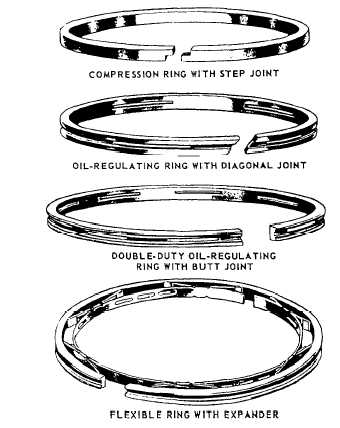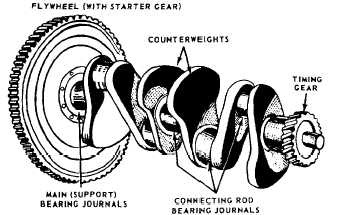Figure 12-18.-Piston rings.
Connecting Rods
Connecting rods must be light and yet strong
enough to transmit the thrust of the pistons to the
crankshaft. Connecting rods are drop forged from a steel
alloy capable of withstanding heavy loads without
bending or twisting. Holes at the upper and lower ends
are machined to permit accurate fitting of bearings.
These holes must be parallel.
The upper end of the connecting rod is connected to
the piston by the piston pin. If the piston pin is locked
in the piston pin bosses or if it floats in both the piston
and the connecting rod, the upper hold of the connecting
rod will have a solid bearing (bushing) of bronze or
similar material. As the lower end of the connecting rod
revolves with the crankshaft, the upper end is forced to
turn back and forth on the piston pin. Although this
movement is slight, the bushing is necessary because of
the high pressure and temperatures. If the piston pin is
semifloating, a bushing is not needed.
Figure 12-19.-Crankshaft of a four-cylinder engine.
The lower hole in the connecting rod is split to
permit it to be clamped around the crankshaft. The
bottom part, or cap, is made of the same material as the
rod and is attached by two or more bolts. The surface
that bears on the crankshaft is generally a bearing
material in the form of a separate split shell; in a few
cases, it may be spun or die-cast in the inside of the rod
and cap during manufacture. The two parts of the
separate bearing are positioned in the rod and cap by
dowel pins, projections, or short brass screws. Split
bearings may be of the precision or semiprecision type.
The precision type bearing is accurately finished to
fit the crankpin and does not require further fitting
during installation. It is positioned by projections on the
shell that match reliefs in the rod and cap. The
projections prevent the bearings from moving sideways
and prevent rotary motion in the rod and cap.
The semiprecision-type bearing is usually fastened
to or die-cast with the rod and cap. Before installation,
it is machined and fitted to the proper inside diameter
with the cap and rod bolted together.
Crankshaft
As the pistons collectively might be regarded as the
heart of the engine, so the crankshaft might be
considered the backbone (fig. 12-19). It ties together the
reactions of the pistons and the connecting rods,
transforming their reciprocating motion into rotary
motion. It transmits engine power through the flywheel,
clutch, transmission, and differential to drive your
vehicle.
The crankshaft is forged or cast from an alloy of
steel and nickel. It is machined smooth to provide
12-17



